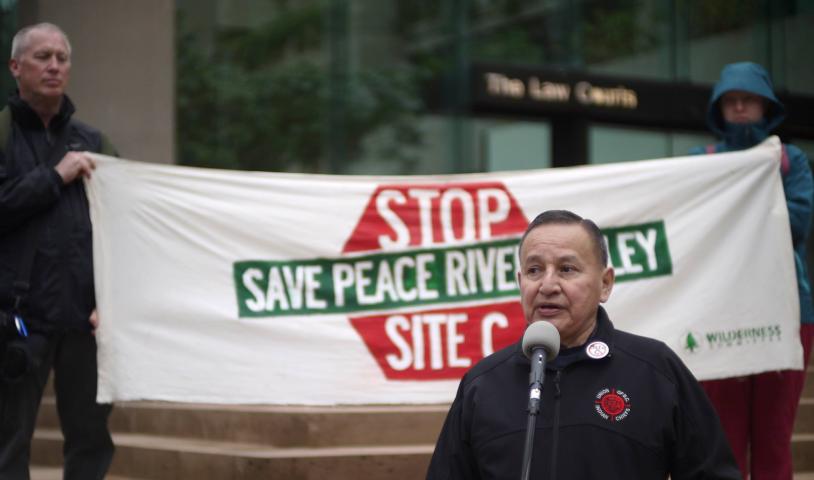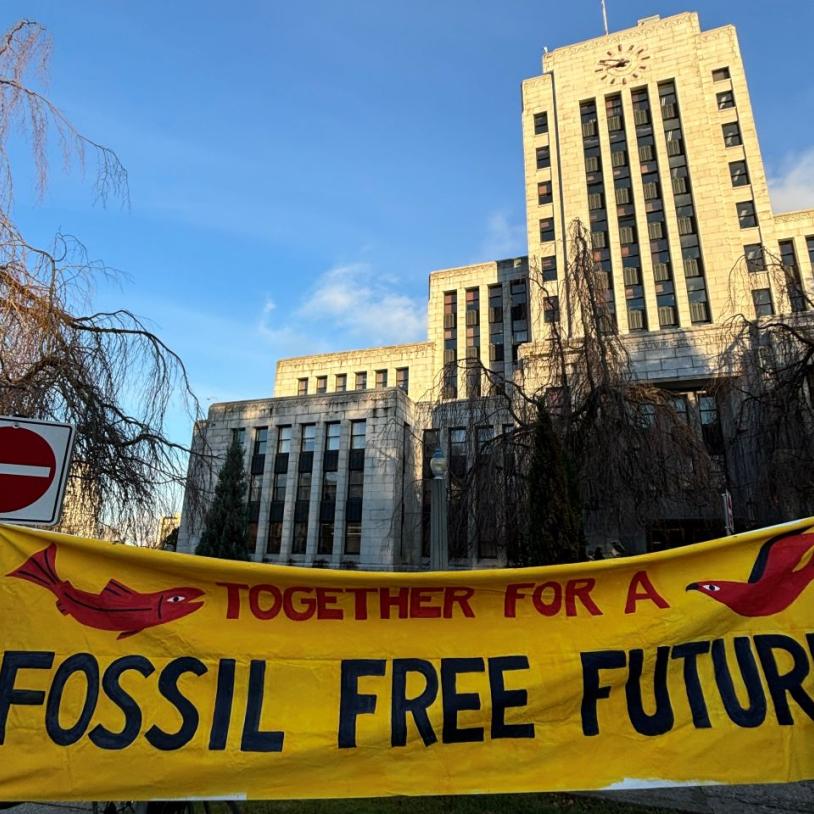BC’S SUPREME COURT GAVE BC HYDRO AN INJUNCTION
Sunday, February 28, 2016
The province’s Supreme Court granted B.C. Hydro an injunction to remove local farmers and First Nations from 216 hectares they wish to clearcut at Site C. The protestors have been occupying Rocky Mountain Fort Camp, in shifts, since December. They have until midnight to leave.
No Acknowledgement of Treaty 8
BC Hydro did not acknowledge that Treaty 8 has any authority over the land they are clearing, though they claim to have “been consulting Aboriginal groups including all Treaty 8 First Nations in British Columbia, as well as local landowners, and members of the public about the Project since about 2007.” In their Notice of Civil Claim, BC Hydro states Rocky Mountain Fort is “on Crown Land” that the protesters were occupying it without “without authorization of the Minister of Forests, Lands and Natural Resource Operations.”
In a recent interview with this reporter, Chief Roland Willson of West Moberly First Nation, said the province did not consult with them before Premier Gordon Campbell announced his intention to proceed with the Site C project in 2007.
“They invited us the afternoon that he showed up. They called us up and asked if we wanted to attend. They had planned it for a month and waited until the last minute to call us. We went out there and they said they are moving forward on Site C,” he said.
“They had already made their decision they were building that. That is not consultation, that is information. They were informing us of their decision.”
“ … We offered them reasonable accommodation measures. We told them we would work with them with a geothermal plant; we would work with them on a gas fired power plant. Anything to save the valley, but they refused.”
Two of the protestors at Rocky Mountain Camp are descendants of of the Chiefs who signed treaty 8 in 1911, which gave First Nations the use of the land to be submerged for “as long as the sun shines, the grass grows and the river flows.”
Helen Knott, a great, great, granddaughter of Chief Bigfoot, described her participation in the occupation of Rocky Mountain Fort Camp as “practising my treaty rights.” She said neither B.C. Hydro or the provincial government have acknowledged the treaty.
“That is why we informed them, every day we were down there, that this is treaty 8 territory and the land was actively being used by treaty 8 members.”
BC Hydro’s Schedule Could Suffer Irreparable Harm
BC Hydro claimed they would suffer “irreparable harm” if the injunction was not granted.
“The construction schedule for the Project is complex, and requires the coordination and sequencing of multiple activities and contractors, seasonal constraints, and the mobilization of a large amount of equipment and number of workers …”
The protesters needed to be immediately removed “because of prohibitions imposed on the construction schedule requiring the avoidance of active birds nests, if RSEM R5A (Rocky Mountain Fort) is not cleared by the window ending March 31, 2016, it will not be practically feasible to clear the area until the fall of 2016.
They also argued that the protestors are “Constructing structures on Crown land and damaging or altering a protected heritage site without authorization …”
A fur trading depot stood on the Site of Rocky Mountain Fort between 1793-1804.
The whole area will be submerged after the dam is built.
An Example Of Bullying Out Disagreement
BC Green leader Andrew Weaver described Site C as “a project that has been aggressively pushed through by this government” with “exemptions on oversight every step of the way.”
“The government has done everything it can to push aside dissent without reasonable justification. This injunction is, to my mind, another example of bullying out disagreement, rather than listening to the concerns of British Columbians,” he wrote.
“Premier Christy Clark, with the help of Justin Trudeau, is forcing the project through despite opposition by locals and First Nations in the area that hold some significant title,” said NDP Environment Critic Nathan Cullen.
With the Help Of Justin Trudeau?
First Nations attempts to communicate with Canada’s Federal Government have largely been “met with silence.”
“We issued a three point plan earlier on in the stages, requesting meetings. That was also met with silence. So when we knew when the injunction court date was, we decided to make the trip to Ottawa in an effort to be heard,” said Knott.
They were gone for four days and unsuccessfully tried to see:
- Catherine McKenna (Minister of the Environment and Climate Change),
- Jim Carr (Minister of Natural Resources),
- Hunter Tootoo (Ministry of Fisheries and Oceans),
- Jody Wilson-Raybould (Minister of Justice and Attorney General of Canada)
- and Carolyn Bennett (Minister of Indigenous and Northern Affairs).
“With most of them it was, not being able to, or they weren’t in the area when we were there. With Carolyn Bennett, I got a phone call from her policy advisor and we were able to meet with him. With the Department of Fisheries and Oceans, it wasn’t until we were there that we got an email saying they could set up an appointment with someone senior in the department, but after we agreed no one got back to us,” said Knott.
She added, “We were able to meet with various NDP MPs, one Liberal MP (Pamela Goldsmith-Jones) and Elizabeth May from the Green Party.”
Treaty 8 Mentioned During Question Period
On February 22 and 23, the matter was brought up in Question period.
Romeo Saganash (NDP) asked why the government ” … is refusing to hear the appeal from First Nations who are opposed to the Site C Dam Site In British Columbia.”
Nathan Cullen (NDP), pointed out that, “ … Even after the review panel found that the mega-dam would have irreversible and negative impacts on the rights of Treaty 8 people, the Minister of Fisheries is still signing permits. Consultations have been inadequate. Letters have been ignored…”
Elizabeth May added, ” … The Minister of Indigenous and Northern Affairs should commit to not allowing further permits to be issued while treaty rights for indigenous people remain outstanding.,”
In their responses, both McKenna and Carr did not use the words “Site C” or “Treaty 8.”
However McKenna did say, “The project is now at construction phase and B.C. Hydro must meet the requirements set out in the environmental assessment decision as well as other regulatory requirements.”
Justice Butler’s Decision
In his verbal explanation for issuing an injunction, Justice Bruce Butler said he was not prepared to deal with the validity of Treaty 8 issues. Two key reasons for his decision were:
- Both the Canadian and British Columbian governments have given BC Hydro permits to proceed.
- Though three are being appealed, at this point there have been four court cases against this project and every one has failed.
(A more detailed, and accurately worded, version of the judge’s decision should be available in the next day or so.)
The Fight Is Just Beginning
Chief Stewart Phillip described this verdict as a bump in the road. People shouldn’t lose heart. The fight for the Peace River is just beginning.
“The Prime Minister has to step in now to protect the honour of the Nation. It will not do any good apologizing to members of the treaty 8 First Nations ten years from now, for drowning 100 kilometres of their territory. I’ve heard too many apologies. It is dishonourable. We know this is wrong now,” said Joe Foy of the Wilderness Committee.
Helen Knott’s Statement to The Press
Helen Knott wrote the following press release:
“Today’s court decision is a deep disappointment. By choosing to award BC Hydro an injunction, the court ignores the constitutionally protected rights of all Treaty 8 members to carry out their cultural practices—to hunt, fish and trap—on their lands, lands governed by a historic treaty signed with the Government of Canada.
“Even more disappointing, the court heard and ignored evidence that it would actually cost Canadians and British Columbians nothing to, at the very least, temporarily delay construction of the dam. Four respected economists agree that a delay to Site C would save, not cost, B.C. ratepayers and taxpayers money. This is because Site C is being built before it is needed and its power will be sold at a loss.
“The Rocky Mountain Fort Camp is an historic site that stands at the gateway to the pristine Peace Valley. I, along with many other First Nations people, local farmers, landowners and other supporters, have occupied the site peacefully since the beginning of the new year because we are opposed to further construction work at the proposed dam.
“Until the unfortunate decision reached today in the B.C. Supreme Court, the Rocky Mountain Fort camp was a symbol of co-existence between Treaty 8 peoples and settlers. Now it is at grave and imminent risk of becoming a symbol of Prime Minister Trudeau’s failed promise to respect indigenous peoples and their rights when issuing federal permits.
“The Court has now authorized the unjustified infringement of our treaty rights. It has granted BC Hydro and the RCMP the right to clear the camp and if necessary, arrest us.
“We do not wish to be arrested. We wish to see Canada respect the rights of indigenous people in accordance with its international obligations. We remain strong, united and firm in our opposition to this unnecessary project. We will do everything in our power to ensure Canada lives up to its commitments to indigenous peoples.”
Read the original article here
Photo: Site C Supreme Court hearing, Vancouver (Joe Foy)





